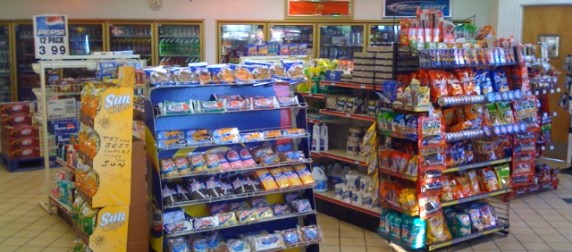For those of you with less than pure thoughts, got ya! I don’t write on customer service issues very often, once or twice a year, and it usually has to do with how to treat them with respect, how to enhance their experience, or how to engage them more thoroughly and for longer. But sometimes, you just want to get in, get yer stuff and get out, and that’s not always a bad thing.
The thought of speed in a transaction is a foundation in certain sectors of brick and mortar retail – groceries, convenience, gasoline, and the like for instance. They aren’t large footprint locations, don’t have much room for folks to be roaming around, and studies have shown that they often are in a hurry or have a set list of things they need, and that total receipt won’t change much due to them lingering. They make up for this by providing a lot of opportunities for impulse buying while they have you the most captive – at the cash register. Some of these locations are so ardent about this, that they have arranged the items packed so closely together you can hardly see the cashier for the racks of stuff! But you can still get in, pick up your choices off of easily selectable shelves and quick-grab racks, get in a line (if there even is one) and pay inside of a couple of minutes, seemingly regardless of the number of items.
In that instance, that’s good customer service – you gave the customer exactly what they wanted – speed. Their expectations were met and you’ve given them exactly what they needed, a no-frills transactional approach to commerce without a lot of fuss or conversation. Some of this is possible due to technology – they have the fastest register software available and the simplest, most common-denominator pricing and indexing for inventory of anyone in the business of retail. But some of it has to do with design, layout, and most importantly, human behavior.
The reason people shop at convenience stores is exactly that – convenience. They don’t go bargain hunting, they don’t argue over the $3 mini bag of Cheeze Curlz, they don’t bring coupons (there aren’t any), and they often aren’t terribly loyal when it comes to brand. They’ll pay a premium for the speed and won’t argue about it with the cashier, who says as little as possible during the transaction. They’re not folksy, they’re not chatty, they don’t know you most of the time, and don’t plan on seeing you again, ever. No need to form a relationship, just bag the chips and the soft drink and move on.
That’s not to say that you feel rushed, or hurried, or that the service is brusk or rude, because its not. It’s just devoid of emotion, good, bad, or indifferent. They serve a function, do it well, and please the customer – job done. For the cashier, this is a relatively simple, boring to the point of inanity, potentially dangerous job, often on an odd shift, done for the short-term based on a dearth of marketable skills and a need for capital – it’s not a career position. For the customer, it’s a quick pit stop with a specific purpose, no browsing or emotion required, and if they happen to find something whimsical or amusing at the register, or something there reminds them of another item they need, so much the better for everyone – what the heck, it’s only two bucks, right?
Other types of retailers can benefit from this approach as well, specifically online. Everyone’s focus in the early days of web commerce was to extend “dwell time” – how long are they lingering on the site, what are they looking at, what page and what item draws their attention, were key metrics. Consumers were still getting used to shopping online, and there had yet to be developed standards of usability or code norms for websites, so the customer had to not only learn how to find the items they were looking for, but how to work the website in order to get them, from the shopping presentation matrix to the sizing and customizing of the item, to calculating the shipping time and cost, to the payments page(s), it was a learning experience, not so much a shopping experience.
More recently, shoppers have gotten vary familiar with all the bells and whistles of online commerce, web designers have figured out how to present non-static digital items for greatest effect, and how to lay out pages intuitively so that your eye and cursor travels to what you want almost effortlessly. It’s a strong advantage, and only recently have online shoppers been allowed the freedom to use their own data to speed the process along. For commerce sites you frequent, there is significant data from your prior transactions that allows both you and the retailer to benefit.
I frequent a couple of gift sites for things I send to clients for the holidays, and after a few years, I can visit them, select, buy, address and ship about 20 items in less than 30 minutes – blazing speed compared to a trip to a crowded mall, let alone the gift wrapping, boxing, shipping, and distribution time and cost. All the addresses are already there, my selections from last year and prior are logged, and it reminds me if, in my shopping haze, I duplicate a previous gift – nice feature for us oldsters. The shipping is often either included or free based on frequency and volume, and I know the quality and presentation are top notch with out having to investigate further – a quick in and out transaction that by no means diminishes the thoughtfulness of sending a gift to a loyal client.
Sometimes providing a great customer experience really means delivering on your brand promise, as long as it’s been accurately telegraphed ahead of time. I know the convenience store doesn’t have premium brands, I know their selection is rather limited to a certain type of merchandise, and I know that I’m not going to get a bargain, or be met at the door and asked if I’d like a sample of Chai latte while I shop, or that the cashier is going to gushingly ask if there’s “anything else she can do for me.” But I also know they’ll have what I need to get by, right now, and get me back out and on the road without having to do anything special, or even say a word. Sometimes, that’s a great experience!





